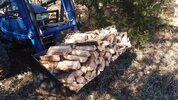A lot of folks look to the past and the ways we lived before industrialization for clues about what a post-economic then societal collapse may look like.
Back in colonial America, firewood was Life.
If you lived in a village, town, or city, it had to be brought in where it would then be sold. In fact, before the 18th century even began, there are letters from city dwellers complaining that they had to go five miles out of town just to find enough trees to cut and bring home.
Most Colonial homes would use about 40 cords of wood per year.
And before anyone shrugs because they don’t like in a city, Boston’s population in 1760 was only 15,631….only 44% the size of modern day Salisbury, NC (35,760 in 2021) which can hardly be called a major city.
Considering a cord of wood weighs 2,000 to 3,000 lbs (though depending upon the type of wood, could be as high as 5,000 lbs/cord), that means the average household in colonial America was using between 80,000 and 120,000 lbs of wood per year.
And considering all of that wood had to be felled, transported, split, stacked, and seasoned - it’s almost incomprehensible in the 21st century to understand how much work is saved daily because of modern technology.
There were still fields to be tended, game to be hunted, home maintenance…..
So if this is a consideration you’re making as part of your preps - understand the sheer magnitude of work that’s required and take that into account.

Back in colonial America, firewood was Life.
If you lived in a village, town, or city, it had to be brought in where it would then be sold. In fact, before the 18th century even began, there are letters from city dwellers complaining that they had to go five miles out of town just to find enough trees to cut and bring home.
Most Colonial homes would use about 40 cords of wood per year.
And before anyone shrugs because they don’t like in a city, Boston’s population in 1760 was only 15,631….only 44% the size of modern day Salisbury, NC (35,760 in 2021) which can hardly be called a major city.
Considering a cord of wood weighs 2,000 to 3,000 lbs (though depending upon the type of wood, could be as high as 5,000 lbs/cord), that means the average household in colonial America was using between 80,000 and 120,000 lbs of wood per year.
And considering all of that wood had to be felled, transported, split, stacked, and seasoned - it’s almost incomprehensible in the 21st century to understand how much work is saved daily because of modern technology.
There were still fields to be tended, game to be hunted, home maintenance…..
So if this is a consideration you’re making as part of your preps - understand the sheer magnitude of work that’s required and take that into account.







